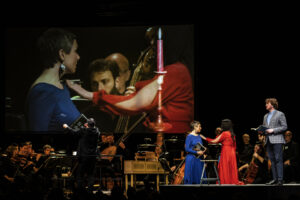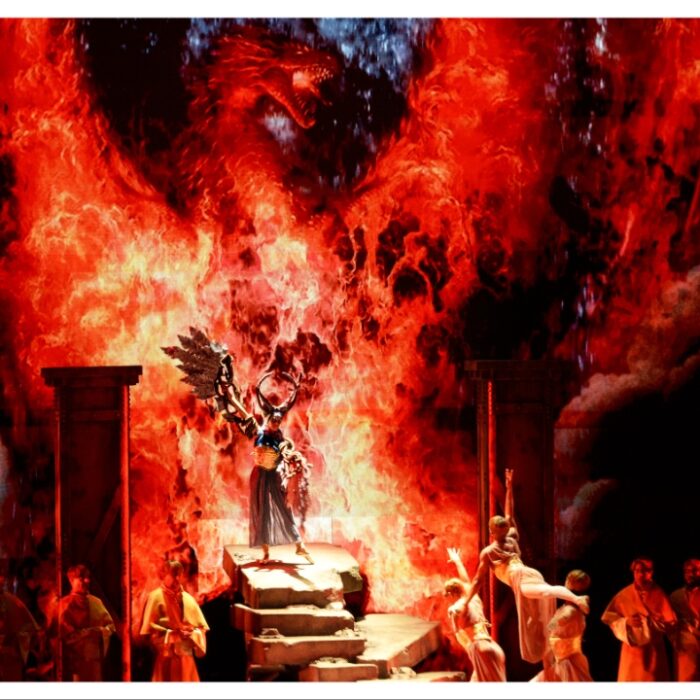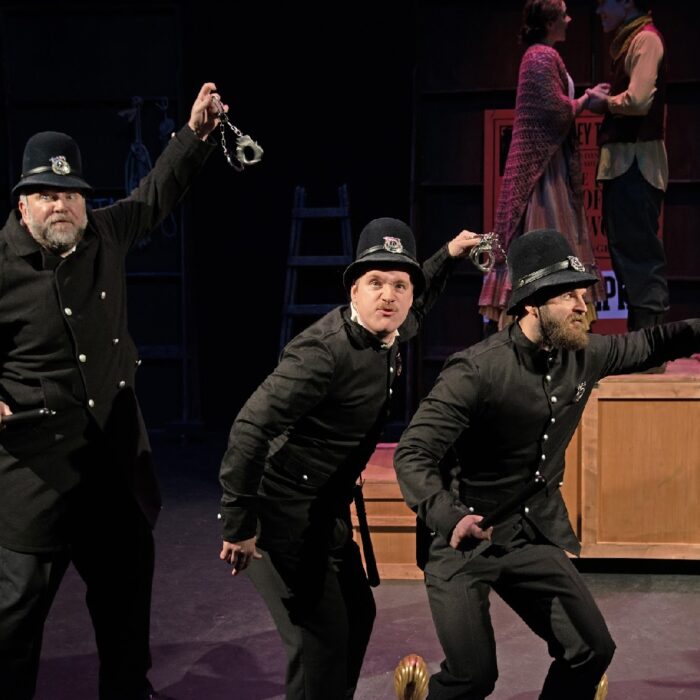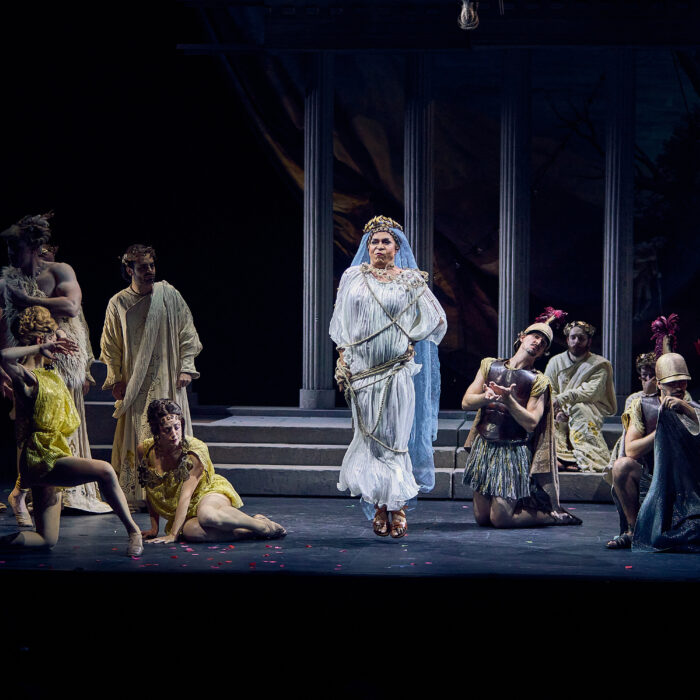
Göttingen International Händel Festival 2024 Review: Il Trionfo del Tempo e del Disinganno
Petrou Oversees A Stunning Musical Performance
By Alan Neilson(Photo: Alciro Theodoro Da Silva)
Productions of Handel’s 1707 oratorio “Il Trionfo del Tempo e del Disinganno” in its first version (HWV 46a) are by no means rare. A conversational piece with plenty of contrasting moods and emotional tension but little in the way of physical action, it is often presented as a concert performance, although successful staged productions are not unusual. Göttingen’s International Handel Festival opted for a concert performance; however, such was the quality of Ilka Seifert‘s direction and Folkert Uhde‘s staging that even without scenery or costumes, it successfully captured many of the qualities of a fully staged performance.
The work is an allegory centered on Bellezza (Beauty), who is encouraged by Piacere (Pleasure) to follow a life of thoughtless diversion, while Tempo (Time) and Disinganno (Enlightenment) warn her to abandon such a frivolous path in favor of truth and so gain a place in heaven! It is a work with a message that reflects and promotes the librettist Cardinal Pamphilj’s own religious philosophy, in which he appears to reject the idea of virtuous pleasure.
The initial impression of seeing the jumbled stage at Göttingen’s Stadthalle left one feeling a little confused. Everything appeared to be awkwardly arranged, certainly not as one would expect for a standard concert. The orchestra was situated slightly to the left, with a raised area to the right, on which was positioned a large mirror along with a chair. From the left-hand side, at the rear of the stage, stood a screen stretching about two-thirds of its length, from behind which the singers emerged. Its purpose was to support video projections used throughout the performance. The chairs for the singers were not positioned on either side of the conductor’s podium as is normal but were almost hidden from view behind the orchestra.
Seifert & Uhde Dramatically Conceived Staging
Initially, it was all somewhat disconcerting, as the stage lacked a central focal point. Instead, the eye was encouraged to roam over the stage from one point to another, and as it turned out, it proved to be very successful.
The fragmented nature of the stage was deliberately accentuated by Seifert and Uhde’s presentation, which allowed the audience a degree of choice on how it wished to engage with the performance. This was not a static concert. From the opening sonata, in which Bellezza appears and admires herself in the mirror, the artists were encouraged to immerse themselves physically in their characters; they may have been reading from a score, but they were also moving about the stage, interacting with the other singers and occasionally with members of the orchestra. Throughout the performance, live images of the orchestra and the singers were projected onto the screen, sometimes in the form of a semi-collage, which simultaneously highlighted the singers’ emotional states and created aesthetically powerful images. The audience was thus free to decide whether to focus on individual singers or George Petrou’s conducting style; it could choose to watch the wonderful projections or simply flit from one area of the stage to another.
It may have been advertised as a concert but visually it had more dramatic depth and strength than many fully staged productions. It was excellent! Moreover, it offered a format for broadening the dramatic element of operas and oratorios given as concert performances.
Petrou’s Masterful Musical Insights
As excellent as the staging was, the real strength of the presentation was Petrou’s magical musical direction, in which he elicited a stunning performance from the Festspielorchester Göttingen. From the opening sonata to the very last aria, each number was exquisitely fashioned to bring out its beauty along with its full emotional charge. It really was a riveting performance. The sensitivity and nuance he brought to the interpretation, along with the elegance and overall sense of balance, was a testament to the deep connection Petrou has with Händel’s music.
In Part one, soprano Anna Dennis, as Bellezza, spent a not inconsiderable time looking admiringly into the mirror, where she was met with a self-satisfied video image of herself. She welcomed Piacere with open arms and was irritated by Tempo and Disinganno’s presence. In Part two, the video on the large screen presented her as more conflicted and troubled. Exposing her in this way highlighted her feelings, which Dennis expertly complemented with an appealing singing portrait. Her voice possesses a luminescent quality with varying degrees of brightness. It is resonant, clear and beautifully balanced, which she showed off delightfully in the aria “Venga il Tempo,” dancing spritely across the vocal line and engaging freely in light coloratura passages. Possibly the finest moment of the whole performance was the final scene in which Bellezza pledges her heart and soul to God in the aria “Tu del Ciel ministro eletto,” and brings the oratorio to its conclusion. It was masterfully staged, in which Dennis, accompanied by a solo violinist seated alone on the raised part of the stage, produced a refined, graceful and elegant rendition and created a very special moment.
As Piacere, soprano Emöke Baráth cajoled and tempted Bellezza into following a life dedicated to pleasure, charming her with a series of arias that highlighted her beautiful vocal coloring, nuanced phrasing and subtle expressivity. All were sensitively delivered with a degree of understatement, so that the explosive effect of her final aria, “Come che fugge col ventio,” in which she voiced her frustrations at being defeated by Tempo and Disinganno, was brilliantly magnified; venting her frustrations with a vocally agile presentation, she employed complex passages of coloratura, leaps and imaginative embellishments underpinned by colorful and dynamic contrasts and neatly placed accents. Piacere also sings the work’s most famous aria, “Lascia la spina,” which requires very different qualities and for which Baráth produced a show-stopping performance founded upon the subtlety, delicacy and a gentle expressivity that captured the beauty of the piece.
The countertenor, Xavier Sabata, produced a beautifully sung portrait of Disinganno. His sensitive phrasing, smooth legato and ability to ornament the vocal line, along with his ability to carry the melody, endeared him to the audience. This was nowhere better illustrated than in his sweetly rendered aria “Crede l’uom ch’egli riposi,” in which he caressed each line of the A section with the utmost delicacy and emotional depth, which he contrasted superbly with a passage of punchy, staccato coloratura in the B section. His recitatives were well-presented, beautifully capturing his character’s certainty and wisdom.
Tenor Emanuel Tomljenovic proved to be a somewhat aloof Tempo. Although he possesses a pleasing voice that displays flexibility, his performance was a little too conservative; he appeared to be content to remain within his comfort zone, particularly when delivering his arias, which compromised his characterization, even if he did successfully capture the emotions in what was a solid, if not exciting performance.
It was an evening to remember. Musically and dramatically, it was a performance par excellence. Even if billed as a concert performance, Seifert managed to create a visual dimension that added a subtle dramatic layer to the work that one would be thrilled to find in a fully staged production.



